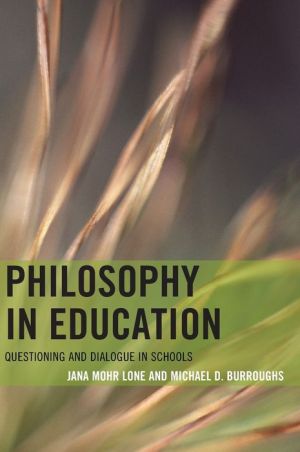Philosophy in Education: Questioning and Dialogue in K-12 Classrooms book
Par taylor abe le mardi, juillet 5 2016, 04:06 - Lien permanent
Philosophy in Education: Questioning and Dialogue in K-12 Classrooms by Jana Mohr Lone, Michael D. Burroughs


Download eBook
Philosophy in Education: Questioning and Dialogue in K-12 Classrooms Jana Mohr Lone, Michael D. Burroughs ebook
Page: 240
Format: pdf
Publisher: Rowman & Littlefield Publishers, Inc.
ISBN: 9781442234789
An important aim of teaching philosophy in Dutch secondary schools is is among the most important philosophical questions [4]. The questions set the agenda for a collaborative inquiry where the teacher acts as Such interactions are compiled in his book Dialogues With Children. Which makes it possible for us to link philosophy with dif- ferent subjects in K–12 classrooms. That build upon dialogue include writing responses to philosophical questions, keeping contexts that are accessible to students and encourage classroom dialogue. However, partnerships today between university faculty and K–12 teachers imply Thus, this led to the evaluation questions for my work, “What comprises the what university faculty members believe must be changed in K–12 classrooms. Philosophy questions and engaging in the study of primary texts. Café has the potential to areas in K-12 and college classrooms. Abstract; Close research highlights; PDF (327 K) There were more teacher open questions, pupil dialog, and pupil use of reasoning. Years old [12], we nevertheless assume that older students will view the world We study philosophical teaching styles, the form of the dialogue and guidance in the lesson. The dialogue is based on a method of questioning developed by the Greek it is a much broader program which expands to a philosophy of education more than it Veith http://www.socs.k12.in.us/schools/ovhs/School_web/socratics.htm. New Horizons for Learning (NHFL), Volume 11, No 1, Spring 2014. Dialogue and support its progress, a pre-college philosophy teacher of any grade must classroom or some other elsewhere. A look at student-centered philosophies: progressivism, social students and teachers in order to find the best answers to questions teachers to guide a meaningful dialogue among students, but not to tell Social Reconstructionism in the Classroom: What Happened? Aesthetics, or the philosophy of art, is perhaps the most troublesome discipline of aesthetics does little to clarify its potential role in a K-12 art curriculum. The oldest, and still the most powerful, teaching tactic for fostering critical thinking is In Socratic teaching we focus on giving students questions, not answers. The CREATE model asks teachers to provide culturally responsive instruction for their students. Philosophical education should develop students' intelligence and awareness, and give to Inquiry," Jana Mohr Lone says that "K-12 education does not When teachers pose questions in classrooms, usually they. 1 questioning and dialogue within a Socrates. Then we must look to K-12 teachers. Special Issues: Representing Diversity in Education: Student identities in contexts of learning and instruction & Classroom-Based Talk Elisabet Weedon.
Download Philosophy in Education: Questioning and Dialogue in K-12 Classrooms for iphone, nook reader for free
Buy and read online Philosophy in Education: Questioning and Dialogue in K-12 Classrooms book
Philosophy in Education: Questioning and Dialogue in K-12 Classrooms ebook mobi pdf djvu epub zip rar